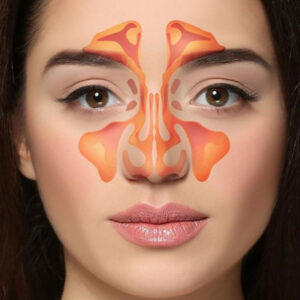
Nasal Cancer Treatment: Beyond being the entrance gate to the respiratory system, the nose plays a critical role in voice, smell, taste, and facial aesthetics. However, malignant tumors developing within this complex structure, namely nasal cancer, can seriously affect patients’ quality of life with both local and systemic effects. Although nasal cancer is rare, its diagnosis may be delayed due to the difficulties of its anatomical location, which can complicate the treatment process.
Thanks to surgical, radiotherapy, chemotherapy, and targeted treatment approaches offered by modern medicine, quite successful results can be achieved in nasal cancer treatment today. ENT Specialist Prof. Dr. Ozan Seymen, who serves in his own clinic in Istanbul, offers his patients multidisciplinary and individualized solutions in the early diagnosis and effective treatment process of nasal cancer.
What is Nasal Cancer?
Nasal cancer refers to malignant tumors originating from the mucosal layer covering the inner surface of the nasal cavity. These cancers are generally evaluated together with paranasal sinus cancers. The most common type is squamous cell carcinoma. Besides this, there are also rarer subtypes such as adenocarcinoma, adenoid cystic carcinoma, malignant melanoma, and esthesioneuroblastoma.
Nasal cancer usually begins in the nasal tissues and spreads to surrounding tissues. Since it is difficult to diagnose in the early stages, the disease is usually detected in advanced stages. Therefore, careful monitoring of high-risk groups and timely evaluation of suspicious symptoms are extremely important.
What Causes Nasal Cancer? What are the Risk Factors?
Although the exact cause of nasal cancer is not known, some environmental and lifestyle factors may influence the development of the disease. These risk factors include:
Exposure to wood and leather dust: The risk of adenocarcinoma increases especially in carpenters, shoemakers, and furniture workers.
Exposure to chemicals: Those who work with substances such as nickel, chromium, and formaldehyde for a long time have a higher probability of developing cancer.
Smoking: It is a basic risk factor in the formation of all head-neck cancers, especially squamous cell carcinoma.
Chronic nasal infections and sinusitis: Constant inflammatory conditions can cause mucosal changes.
Genetic predisposition: Individuals with a family history have a higher risk of developing cancer.
Viral infections such as HPV and EBV: A relationship has been established with some subtypes.
Prof. Dr. Ozan Seymen recommends regular ENT examinations for individuals in the risk group and that long-lasting symptoms should be taken seriously.
What are the Symptoms of Nasal Cancer?
Nasal cancer symptoms are generally mild and insidious. Therefore, they are often confused with simple ailments such as rhinitis or sinusitis. The following symptoms should be carefully evaluated, especially when they are unilateral and long-lasting:
- Unilateral nasal congestion
- Bloody or foul-smelling nasal discharge
- Swelling or mass sensation inside the nose
- Pain, swelling, or numbness in the face
- Watery eyes, vision disorders, or pushing of the eyeball
- Toothache, tooth loss, or drooping of the upper palate
- Lymph node swelling in the neck
- Decreased sense of smell
If one or more of these symptoms are present, a detailed evaluation by an ear, nose, and throat specialist should definitely be performed.
How is Nasal Cancer Diagnosed?
Nasal cancer diagnosis is made through the simultaneous use of clinical evaluation, endoscopic examination, and advanced imaging methods. The diagnostic process generally includes these steps:
Endoscopic nasal examination: The inside of the nasal cavity is examined in detail with an endoscope.
Computed Tomography (CT): Important for evaluating bone structures.
Magnetic Resonance Imaging (MRI): Shows soft tissue involvement and nerve-spread pathways.
Biopsy: A definitive diagnosis is made by pathologically examining a tissue sample taken from the suspicious area.
PET-CT: Used to investigate the presence of metastasis and for staging.
Prof. Dr. Ozan Seymen meticulously conducts both the diagnosis and staging process, creating the treatment planning in the most accurate way.
How is Nasal Cancer Treated?
The aim in nasal cancer treatment is to completely eliminate the tumor, stop the spread of the disease, and preserve functional structures. The treatment to be applied is determined by considering the type and stage of the disease and the patient’s general health condition.
Surgical Treatment
Surgery is generally the primary treatment method in nasal cancer. The aim is to remove the tumor with endoscopic or open techniques. The scope of application may include:
- Removal of tumor tissue with wide margins
- If necessary, removal of surrounding tissues (bone, septum, soft tissue)
- Aesthetic and functional reconstruction in the nose and face area
Prof. Dr. Ozan Seymen plans surgery considering both oncological success and aesthetic-mimic harmony.
Radiotherapy
Radiotherapy can be applied as an adjuvant after surgery or alone in cases not suitable for surgery. Thanks to modern techniques, the targeted tumor area is treated with high-dose radiation while healthy tissues are protected.
Chemotherapy
Systemic chemotherapy is applied in advanced stages, in cases with local invasion or risk of metastasis. Chemotherapy can be used together with radiotherapy (concomitant) or before surgery (neoadjuvant).
Targeted Therapies and Immunotherapy
Molecular targeted drugs and immunotherapies developed in recent years offer new hope, especially in treatment-resistant cases. These treatments, selected according to the genetic structure of the tumor, help destroy cancer cells by mobilizing the immune system.
Post-Treatment Monitoring and Follow-up
Patients should be followed up at regular intervals after completion of nasal cancer treatment. It is recommended to have check-ups at least every 3-6 months within the first 2 years. Endoscopic examination, imaging tests, and if necessary, biopsy may be repeated in these check-ups. At the same time:
- Aesthetic surgery may be required
- Rehabilitation process may be initiated for smell, speech, or chewing functions
- Psychological support and nutrition counseling may be recommended
Prof. Dr. Ozan Seymen closely follows the healing process by being with his patients at every step during the post-treatment period.
Importance of Early Diagnosis
When nasal cancer is recognized in the early stage, a treatment success rate of over 80% can be achieved. However, in delayed cases, this rate dramatically decreases. Early referral is of vital importance, especially in cases where the above-mentioned symptoms continue unilaterally and for more than 3 weeks.
Nasal cancer treatment is a process in which high success rates can be achieved with multidisciplinary cooperation, correct diagnosis, timely intervention, and patient-specific planning. Thanks to the intelligent combination of surgery, radiotherapy, and systemic treatments, patients can obtain satisfactory results in terms of both lifespan and aesthetic-functional aspects.
Prof. Dr. Ozan Seymen, who serves in his own clinic in Istanbul, provides a scientific and humanitarian contribution to his patients’ struggle for life by combining all the possibilities of modern medicine with a personalized approach in nasal cancer treatment. If you or a relative has persistent symptoms in the nasal area, taking a step to get a specialist evaluation without delay may be one of the right decisions for your health.











 Türkçe
Türkçe Français
Français Deutsch
Deutsch